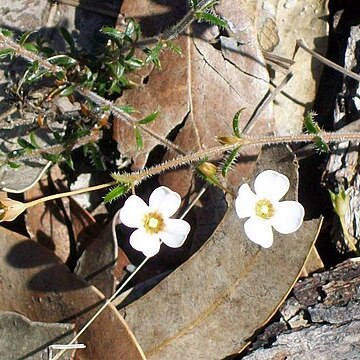Herbs, delicate annual or perennial. Leaves opposite along stem and/or in a whorl at base, subsessile; stipules absent. Flowers axillary and/or terminal, solitary or in pedunculate umbel-like cymes which sometimes rebranch to form irregular compound umbels, 4-merous, white or yellow, rarely pale blue. Calyx campanulate, 2--4-lobed; lobes valvate. Corolla campanulate [salverform or urceolate], often bearded at mouth, tube short to long, lobes exduplicate-valvate in bud. Stamens inserted on lower half of corolla tube; filaments much longer than anthers; anthers introrse, extrorse, or rarely latrorse, included to slightly exerted, 2-locular. Pistil glabrous. Ovary superior to slightly inferior, with many ovules per locule. Style one, base usually parted, rarely 2 separate styles; stigma capitate or 2-cleft. Capsules globose to subglobose, opening by apical loculicidal slits, 2-horned, horns terminated by a style which may be split or remain partly connate, many-seeded. Seeds minute, cylindric-ellipsoid to angular; seed coat thin reticulate to verrucose or almost very minutely papillate; endosperm fleshy.
Herbs. Stem with the leaves rosulate (scapose) or stem partly foliose with the upper fertile part bracteate (scapiform) or wholly foliose. Leaves decussate, sessile or subsessile, rarely petiolate; in scapiform species the upper pairs sometimes appearing whorled; stipules reduced to a connate sheath. Flowers solitary or in umbellate clusters. Perianth 4-merous. Calyx gamosepalous, persistent in fruit. Corolla usually hairy or papillose at throat; lobes valvate. Ovary superior; ovules many; styles 2, in most species connate for most of their length in the upper part, separate at their base and attached to a locule at a terminal horn, or rarely styles separate; stigma 2-lobed. Fruit capsular, persistent, crustaceous, rarely membranous, loculicidal; horns erect, connate along their length or only at apices, rarely undeveloped; style usually hardened and persistent. Seeds minutely and obscurely sculptured, rarely smooth or coarsely reticulate.
Fls us. solitary, axillary; calyx 4-(2)-lobed; corolla valvately 4-lobed; stamens 4, anthers 2-celled dehiscing lengthwise, us. not exserted. Ovary 2-loculed, styles 2, stigma us. capitate; ovules ∞, placentae peltate. Capsule opening along inner margin, seeds ∞.Some 35 spp. from Australia to eastern Asia, the N.Z. spp. endemic.

